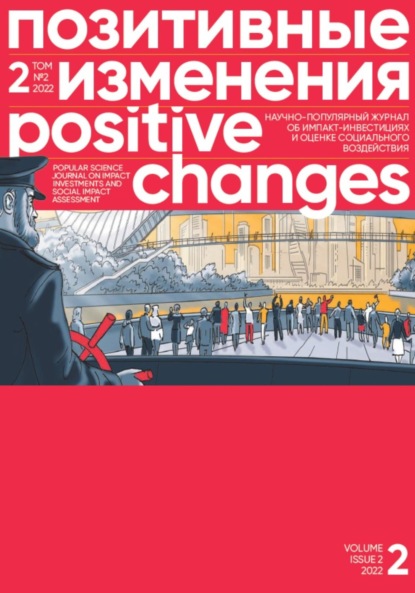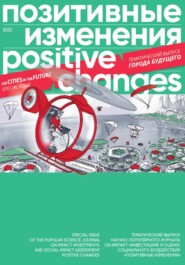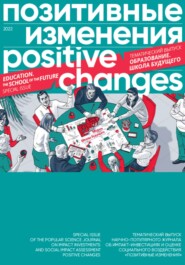По всем вопросам обращайтесь на: info@litportal.ru
(©) 2003-2024.
✖
Позитивные изменения. Том 2, № 2 (2022). Positive changes. Volume 2, Issue 2 (2022)
Настройки чтения
Размер шрифта
Высота строк
Поля
"Many are unaware about the opportunities. Different schools have different approaches. Different conditions lead to unfairness. Young people have an intuitive desire to get united. Today’s young people want to take an active part in the public life of the country, a desire to become better, to develop. And we have to offer this opportunity. Offer it to everyone, whether the child lives in a big city or a village, goes to a rich school or a rural one, whether he or she is a leader or just trying to find himself or herself," Artem Metelev writes in his Telegram channel.
To accommodate the diversity of approaches and interests, the Big Break bill will be subject to widespread public debate. The children will always have the final say on the key issues.
The Big Break All-Russian Children’s and Youth Movement is planned to be established by the largest children’s organizations on an equal footing. Any organization can join the movement, and even adults can join as mentors. In addition, according to the initiative, President Putin will be invited to head the supervisory board.
TWO APPROACHES
In what format could the new children’s and youth movement be demanded and implemented in the best possible way? Experts say that there are two different approaches to working with children’s public organizations. The first (educational) approach involves pattern-based learning and a linear scheme: there is some knowledge, it must be learned and then checked how well it was learned. The second (youth) approach does not involve correct answers. Children can make mistakes, gain experience, analyze, see possibilities, find their own solutions.
"Next time, when a new opportunity comes along, they are already moving on to the next level of management because they have experience of previous mistakes. And this should be cycled. There is no cycle in education, the methodology is linear there. In youth work, there must be a process based on reflective thinking," says Dmitry Sergeyev, social technologist, educator, founder of 18 children’s organizations.
He believes the educational approach does not focus enough on reflection and the possibility of making mistakes. Therefore, there is a risk that each class will become a pioneer squad and there will be a single work plan for all. In addition, a special role in the children’s movement is given to the educator, but the problem is that no one trains them. An educator who works with children must know the history of the children’s movement, understand what project management is, how the public opinion is formed, and be able to work with parents.
"There’s going to be an event plan, and every event will be completed "without a hitch". This is what ruined both the Pioneer Organization and Komsomol in their time, because formally everything was great, but no one paid attention to any shortcomings or problems, and this is the road to nowhere," Dmitry Sergeyev says.
Boris Podolny, deputy head of the executive committee for regional work of the All-Russia People’s Front, notes that schools are increasingly losing their educational function for a variety of reasons. At the same time, it is the school that must ensure the harmonious development of the individual (as a person and as a member of society), if any youth movement is established by the state. For the new movement to take off, three conditions must be met: the will to finance, a clear academic framework (methodological and pedagogical), and the absence of coercion. In addition, it is worth considering the regional specifics.
"We have a very big country, and it’s very diverse. We often forget that. The logic of managing large systems suggests taking one model and applying it to the entire country. In reality, this doesn’t really work very well. The regions are too different, both in terms of living conditions and in terms of geography and scale. In my opinion, the «one-size-fit-all» practice would not work for the whole country, instead there should be a practice tied to different region types," Boris Podolny says.
Olga Zubkova, President of the Friendship Notebook National Association for the Development of Education and author of her own project, the LAMPA International Film Festival of Socially Oriented Short Films, believes that the new movement must take into account the needs of children, so that every child and teenager could find something to their liking.
"There should definitely be counter-vectors. We need to understand what we, the adults – professionals, family, school – can give children in terms of moral education, relevant experience, knowledge and skills. What can we give from what is in demand, taking into account different ages and different needs? We need to understand what children, teenagers, and young people care about in order to find the common ground that would become a starting point or form the conditions for viable technologies," she says.
Boris Podolny adds that in addition to considering the children’s opinions, the views of teachers, psychologists, people with great professional competence and experience are equally important.
"Absolutely, there should be a broad enough discussion not only at the level of collecting feedback from schoolchildren. We now have a tendency of chasing the consumer feedback. A schoolchild is also a consumer in a sense. However, if we endlessly shift responsibility to consumers who have no special competences, we risk getting our results wrong," says Boris Podolny.
THE PAST, THE FUTURE, AND THE FAMILY
What can you take from the past, and what can you positively take from the future? Before answering this question, experts suggest looking at the role of the customer. It is the customer, represented by the state, who must define the parameters of what the output should be.
"Today’s senior school students will be the main productive force of the country 10 years from now. The strategy and ideology of the movement related to the education of the individual and a member of society should be based exactly on the image of the future which the state sees for itself. We need to start with a discussion of what we want our country to be in 20 years, and define the goals we will set for the movement based on that vision," says Boris Podolny.
Also, according to the expert, it is not quite right to rely on models that demonstrated their success in the last century. These models will not necessarily be successful today, because the society is changing too much and too quickly.
According to Olga Zubkova, another customer is the family.
"We keep forgetting about the family. When speaking about counter-vectors, I meant that it would be a good idea to conduct sociological studies involving parents, grandparents, and the children themselves. The family is the main customer. Therefore, what we are going to do with this movement must necessarily take into account the requests of parents," says Olga Zubkova.
Moral values remain the same at all times. "They can be reformulated and presented in any guise, using any wording. Conventionally, "follow your conscience", "help your neighbor", and "strive for the best" are moral guidelines and pillars for life. We cannot call this obsolete, a thing of the past", Olga Zubkova says.
According to the expert, culture plays a significant role here. At present, the children’s film industry in the country is practically undeveloped. "If we do not raise a new generation today with basic cultural values, there is a risk that we will lose it," she believes.
MOVEMENT KPI AND WAYS TO CALCULATE THEM
How will the effectiveness and prospects of the movement be evaluated? How do we know if the Big Break has achieved its goals? Like any government program or social project, the movement must have KPIs. We asked the experts what these indicators could be and how its social impact could be assessed in general.
According to Dmitry Sergeyev, the ideal is when the participants of the movement become independent individuals capable of finding effective managerial solutions in crisis situations, building teams and achieving results.
Among the possible indicators, the expert names social projects of the participants of the movement, how many of the alumni of this children’s organization continue to help this organization, how many parents have a positive attitude toward their child’s membership in the children’s organization.
Olga Zubkova believes that social impact can be measured by the extent to which aggression in children’s communities is reduced.
"I think one of the indicators is just that the child will stop being either the victim or the aggressor. With systematic, talented educational programs, with the interaction between family and school, with positive practices in place that allow children to fulfill their potential as a person, this is achievable. If we see how, on the one hand, an inclusive children’s environment is formed, the children’s community grows more humane, and, on the other hand, the child suicide and depression rates decrease, the incidence of bullying and teenage aggression is reduced, then we can say that we are on the right track," says Olga Zubkova.
Sociological studies may be the most relevant method of assessing social impact, according to Boris Podolny.
"Let me remind you that every process must have a customer, and the customer must have a strategy for what he wants the country to be in 20 years. First, we should measure the baseline numbers. Then follow up a year later, two years later, three years later, five years later, 10 years later. Then we can make conclusions. And the fundamental thing here is not to rush into adopting any strategic, methodological, or other documents. Because the worst thing you can do in or around educational or pedagogical systems is to reform them too often," says Boris Podolny.
The bill is currently undergoing a public review. In the next issue of the journal, based on the opinions and vision of various experts of the Positive Changes Factory as an actor and founder of the journal, we will offer our vision of how the new social children’s and youth movement should be structured.
Экспертные статьи / Expert Publications
«Песочницы» социальных инвестиций: как в мире развиваются проекты Social Impact Bonds
Рынок импакт-инвестиций растет во всем мире, становятся более изящными его формы и виды. Если раньше инвестиции в решение социальных проблем могли быть похожи скорее на траты бюджетов КСО – «отдадим и забудем», то современное состояние рынка диктует другие правила. Новым стандартом становится учет не только вложенных средств, но и оценка социально-экономической эффективности получаемых результатов. Одним из таких «новых» форматов являются не так давно пришедшие и в Россию «СИБы» – называемые так от англоязычного термина Social Impact Bonds.
Иван Смекалин
Аналитик Фабрики позитивных изменений
ЧТОБЫ ПОЛУЧИТЬ, НУЖНО ОТДАТЬ
Проекты облигаций социального воздействия (Social Impact Bonds, SIBs) так же известны как социальные облигации (Weller & Pedersen, 2018). У этого термина встречаются и другие названия: Pay for Success («оплата за успех») и Development Impact Bonds («облигации для ускорения развития»). Несмотря на то, что в англоязычном названии есть слово «облигация» (bond), эти проекты являются подвидом государственно-частного партнерства. SIB – это контрактный и финансовый механизм, в котором возврат инвестиций происходит после достижения социального эффекта.
Государственно-частное партнерство строится на взаимодействии и обязательствах трех сторон:
1. государственное агентство инициирует проект и формирует свои ожидания относительно социального воздействия;
2. подрядчик получает финансирование от инвестора и реализует социальный проект для достижения оговоренных результатов;
3. инвестор предоставляет капитал для подрядчика с ожиданием финансового возврата от государственного агентства в случае достижения результатов социального эффекта.
Сложность проектов по модели SIBs состоит в том, что они сочетают в себе модель предоставления услуг, систему управления проектом, оценки результатов воздействия и систему инвестиций (Andersen et al., 2020). При том, что ключевую роль в принятии решений (и запуска самих проектов) в большинстве случаев играют государственные агентства, их исполнением и финансированием занимаются акторы от частного сектора – и это создает почву для противоречий. Интересы, показатели и цели каждой из сторон могут отличаться.
В частности, можно привести следующие точки возможных противоречий проектов по модели SIBs (Weller & Pedersen, 2018):
1. государство склонно выбирать проекты с самым низким бюджетом, что сказывается на качестве предоставления услуг;
2. де-факто приватизацию государственных услуг сложно объяснить простому гражданину: почему нельзя потратить те же самые деньги, но через государственные институты, а не переводить их на баланс частных игроков?
3. исполнение проекта должно выбирать между приверженностью первоначальному плану и гибкостью для достижения поставленных целей;
4. большой риск инвестора: при соизмеримом риске в рыночных условиях инвестор получил бы большую отдачу от инвестиций, чем при взаимодействии с государством.
МЕДИАТОРЫ И ИХ РОЛЬ
Важно отметить, что взаимодействие в треугольнике стейкхолдеров – государство, подрядчик, инвестор – опосредовано участием медиатора. Такие посредники подразделяются на два типа (Urban Institute, 2020): финансовые и экспертные. Финансовые медиаторы, или координаторы транзакций, осуществляют поддержку в части планирования проекта, защиты инвесторов и обсуждения контракта. Экспертные медиаторы проводят экспертизу дизайна проекта, его стоимости и предлагают метод исследования социального воздействия.









